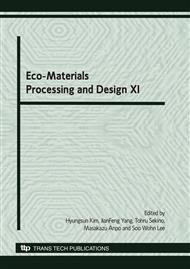p.436
p.440
p.444
p.448
p.452
p.456
p.460
p.463
p.467
Surface Nanocrystallization of Zircaloy-4 by Surface Mechanical Attrition Treatment
Abstract:
A nanostructured surface layer was induced on zircaloy-4 by the method of surface mechanical attrition treatment (SMAT). X-ray diffraction and microhardness tester were applied to identify the average grain size and hardness of specimen processed for different duration, transmission electron microscopy and high-resolution transmission electron microscopy were adopted to observe the microstructure of specimen. The results showed that the surface hardness enhanced gradually and then stabilized with the processing duration increasing, while the average grain size declined gradually, to the minimum 20 nm at 15 min, then increased. The formation of nanocrystalline was due to the mechanical twins and dislocation slip.
Info:
Periodical:
Pages:
452-455
Citation:
Online since:
July 2010
Authors:
Keywords:
Price:
Сopyright:
© 2010 Trans Tech Publications Ltd. All Rights Reserved
Share:
Citation:


